
Anthrosphere
In the last few decades more than 35 million acres of coral reefs have been lost. If that rate continues, 70 percent of the world's coral reefs might die within your lifetime.
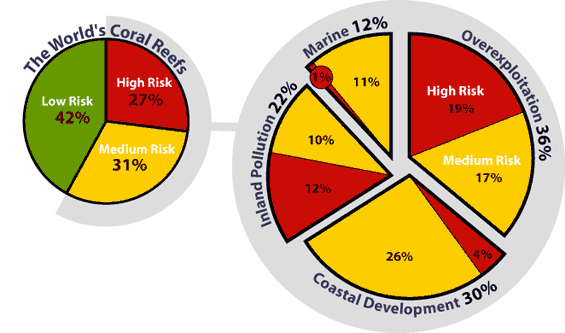
More than half of the world's coral reefs are at
high or medium risk. Overexploitation and coastal development pose the greatest threat to reefs at high and medium risk.
Coral reefs can live only in a delicate, balanced marine environment. They require lots of light and oxygen. They also need clear water, low nutrients, a steady temperature, and stable salt content, or salinity. With all these needs then, it's not surprising that human activities threaten coral reefs.
There are a number of ways we humans can damage such a delicate environment. Among them are deforestation, fishing methods, overfishing, pollution, careless recreation, and nutrient runoff.
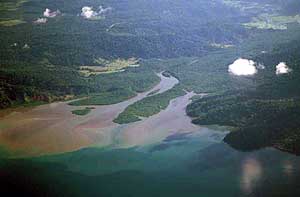 Deforestation
Deforestation
Sediment is the matter that settles to the bottom of a liquid. Think about what happens when land along a coast is developed and built up. Once most of the land is paved over and built on, rainwater runs off into
the ocean, carrying with it various matters, some of them natural, others toxic. In addition, mining or farming upstream causes more runoff and adds to the sediment forming in the ocean. And when trees are cut down in tropical forests for logging, soil erodes easier and rushes downstream and eventually into the ocean. Photo: Aerial view of sedimentation on a delta in southern Costa Rica. Photo © 2003 www.clipart.com.
All the dirt, silt, sand, and human runoff, such as fertilizers and sewage, settle at the bottom of the ocean. That runoff causes water to be cloudy, or what we call turbid, as those materials work their way down to the ocean floor. As a result, the coral can't get enough light and finds itself smothered.
Fishing Methods
Aggressive fishing methods have hurt coral reefs as well, especially in south and southeast Asia. There, fishermen dynamite reefs and inject cyanide into the water. Both these methods stun the fish, making them easier to catch. The fishermen say they have no other option if they are to compete with trawlers and overcome a smaller supply of fish because of previous overfishing. Some estimates indicate that 90 percent of the coral reefs in the Philippines have been harmed so much that they probably can't recover.
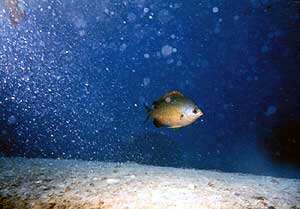 Overfishing
Overfishing
Dynamiting and poisoning reefs are blatant approaches. Less obvious is the damage caused by overfishing. This is a problem in many parts of the world. Many people know the problems cod and salmon fishermen have faced with a smaller supply of fish. However, overfishing of certain species near coral reefs can easily affect the reef's ecological balance and biodiversity. Here's one example.
Grouper is a very popular fish to eat. However, their removal in some cases has led to an increase in damselfish, which groupers feed upon. Damselfish, in turn, create pockets in coral. That's where the algae the damselfish feed upon grow. In time, these algae can take over a reef, essentially smothering it. Overfishing of herbivorous (plant-eating) fish can also lead to high levels of algal growth. Photo: Damselfish add to the destruction of coral reef as they create holes in the coral to eat. Algae then grows in those holes and eventually smother the coral. Photo courtesy of NOAA/Department of Commerce and Dr. James P. McVey.
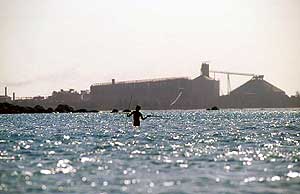 Photo: An Aborigine spearfishes in the shadow of a refinery on the Australian coast. Photo © 2003 clipart.com. |
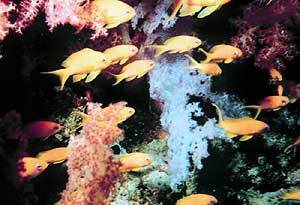 Photo: This reef survives in the Gulf of Aqaba, an area in the Red Sea prone to various forms of pollution. Photo courtesy of NOAA/Department of Commerce and Mr. Mohammed Al Momany. |
Pollution
Water sometimes becomes polluted from petroleum products and other chemicals dumped near coastal waters. These products harm the delicate coral balance. Busy ports add to the problem. For instance, in Jordan the port of Aqaba ships large amounts of phosphate fertilizer. Some of the fertilizer is spilled and enters the Red Sea. It then causes eutrophication. That's when those phosphates stimulate more growth of aquatic life. Eventually oxygen supplies are depleted by the new plants, making it difficult for the coral to survive.
Of course, a more obvious pollution problem is oil spills. The oil makes survival difficult for many forms of aquatic life.
For more information on the Red Sea reefs, check out the Space Station Science Picture of the Day for May 20, 2003.
Careless Recreation
When boats drop anchors, the coral below often is damaged. That's not the only way humans harm the delicate coral with their actions. For instance, when a boat runs aground, coral can be struck and die.
Divers, fishermen, snorkelers and beachgoers can all harm coral.
Nutrient Runoff
When fertilizer runs off the land, it brings more nutrients into
the water. Plants that thrive on nitrogen in the form of nitrates
(contain the NO3- ion) especially benefit. The
fertilizer contains phosphorous in the form of phosphates (contain
the PO3- ion, which is also important in increasing growth in certain plants). This eutrophication (increased nutrients) can reduce biological diversity. As a result, plants that grow well with high levels of nitrogen, such as
benthic (bottom dwelling) algae, grow at the expense of other organisms. This can lead to algal blooms.
Sometimes algal blooms are important in the nitrogen and carbon cycles. For example, an algal bloom occurs each year off the west coast of India for two months beginning near the end of February. However, when an algal bloom occurs near a coral reef, it may smother parts of the coral reef. The algae block the sunlight required by the zooxanthellae in the coral to complete photosynthesis. This has been a problem in the Caribbean and the Florida Keys. In addition to agricultural nutrient runoff, municipal wastes, septic tank seepage, and other sewage—all high in nitrogen—find their way into the sea.
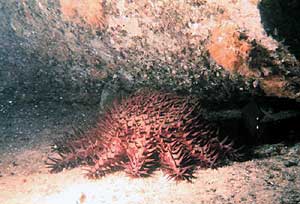 This problem has struck the coral reefs off Australia and Thailand too. Apparently excess nutrients resulted in the growth of plants favored by the crown of thorns starfish. The starfish soon multiplied there. The presence of a large number of them can destroy a reef in a relatively short time span. Photo:
The crown of thorns starfish eats coral polyps. It reportedly is
poisonous if stepped on.
Photo courtesy of NOAA/Department of Commerce and Dr. James P. MCVey.
This problem has struck the coral reefs off Australia and Thailand too. Apparently excess nutrients resulted in the growth of plants favored by the crown of thorns starfish. The starfish soon multiplied there. The presence of a large number of them can destroy a reef in a relatively short time span. Photo:
The crown of thorns starfish eats coral polyps. It reportedly is
poisonous if stepped on.
Photo courtesy of NOAA/Department of Commerce and Dr. James P. MCVey.
Anthrosphere | Atmosphere | Biosphere | Hydrosphere | Lithosphere
Glossary ..|.. Related Links ..|.. References |..PBL Model
Home ..|.. Teacher Pages ..|.. Modules & Activities
Maintained by ETE Team
Last updated
March 08, 2004
Privacy Statement and Copyright © 1997-2004 by Wheeling Jesuit University/NASA-supported Classroom of the Future. All rights reserved.
Exploring the Environment®, Coral Reefs was developed under a cooperative agreement with NASA.
Some images © 2004 www.clipart.com
Center for Educational Technologies, Circuit Board/Apple graphic logo, and COTF Classroom of the Future logo are registered trademarks of Wheeling Jesuit University.